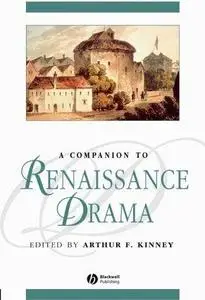A Companion to Renaissance Drama By Arthur F. Kinney (ed.)
2002 | 637 Pages | ISBN: 0631219501 | PDF | 4 MB
2002 | 637 Pages | ISBN: 0631219501 | PDF | 4 MB
This expansive, inter-disciplinary guide to Renaissance plays and the world they played to gives readers a colorful overview of England's great dramatic age.Provides an expansive and inter-disciplinary approach to Renaissance plays and the world they played to. Offers a colourful and comprehensive overview of the material conditions of England's most important dramatic period. Gives readers facts and data along with up-to-date interpretation of the plays. Looks at the drama in terms of its cultural agency, its collaborative nature, and its ideological complexity.Content: Chapter 1 The Politics of Renaissance England (pages 11–24): Norman JonesChapter 2 Political Thought and the Theater, 1580–1630 (pages 25–39): Annabel PattersonChapter 3 Religious Persuasions, c.1580–c.1620 (pages 40–49): Lori Anne FerrellChapter 4 Social Discourse and the Changing Economy (pages 50–67): Lee BeierChapter 5 London and Westminster (pages 68–82): Ian W. ArcherChapter 6 Vagrancy (pages 83–92): William C. CarrollChapter 7 Family and Household (pages 93–108): Martin IngramChapter 8 Travel and Trade (pages 109–120): William H. ShermanChapter 9 Everyday Custom and Popular Culture (pages 121–134): Michael BristolChapter 10 Magic and Witchcraft (pages 135–144): Deborah WillisChapter 11 Playhouses (pages 145–161): Herbert BerryChapter 12 The Transmission of an English Renaissance Play?Text (pages 163–179): Grace IoppoloChapter 13 Playing Companies and Repertory (pages 180–192): Roslyn L. KnutsonChapter 14 Must the Devil Appear?: Audiences, Actors, Stage Business (pages 193–211): S. P. CerasanoChapter 15 “The Actors are Come Hither”: Traveling Companies (pages 212–222): Peter H. GreenfieldChapter 16 Jurisdiction of Theater and Censorship (pages 223–236): Richard DuttonChapter 17 Medieval and Reformation Roots (pages 237–256): Raphael FalcoChapter 18 The Academic Drama (pages 257–265): Robert S. KnappChapter 19 “What Revels are in Hand?”: Performances in the Great Households (pages 266–280): Suzanne WestfallChapter 20 Progresses and Court Entertainments (pages 281–293): R. Malcolm SmutsChapter 21 Civic Drama (pages 294–313): Lawrence ManleyChapter 22 Boy Companies and Private Theaters (pages 314–325): Michael ShapiroChapter 23 Revenge Tragedy (pages 326–335): Eugene D. HillChapter 24 Staging the Malcontent in Early Modern England (pages 336–352): Mark Thornton BurnettChapter 25 City Comedy (pages 353–366): John A. TwyningChapter 26 Domestic Tragedy: Private Life on the Public Stage (pages 367–383): Lena Cowen OrlinChapter 27 Romance and Tragicomedy (pages 384–398): Maurice HuntChapter 28 Gendering the Stage (pages 399–415): Alison FindlayChapter 29 Closet Drama (pages 416–430): Marta StraznickyChapter 30 Continental Influences (pages 432–445): Lawrence F. RhuChapter 31 Christopher Marlowe (pages 446–463): Emily C. BartelsChapter 32 Ben Jonson (pages 464–481): W. David KayChapter 33 Sidney, Cary, Wroth (pages 482–506): Margaret FergusonChapter 34 Thomas Middleton (pages 507–523): John JowettChapter 35 Beaumont and Fletcher (pages 524–539): Lee BlissChapter 36 Collaboration (pages 540–552): Philip C. McGuireChapter 37 John Webster (pages 553–566): Elli Abraham ShellistChapter 38 John Ford (pages 567–583): Mario Digangi



